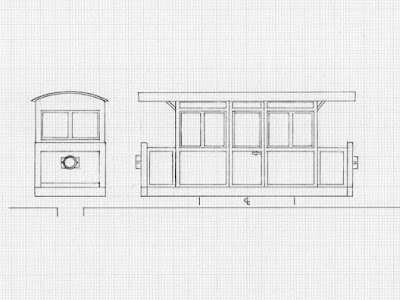It seems like only yesterday, but turns out to be a number of months ago (four to be precise), I was looking at ideas to build an O9 railcar on a Kato bogie chassis. I had hinted at another design to come, which would essentially have been a pastiche version of my Dapol railbus conversions. That has not been drawn up, however with time on my hands I had another look over the various ideas and parts to hand and drew up something that ticks many boxes.
Railway modelling in 7mm scale on 9mm gauge track, representing 15" gauge miniature railways and 18" gauge industrial railways. (Plus anything else that I choose to include!)
Pages
Tuesday, 27 September 2022
A Tramcar Doodle
Saturday, 10 September 2022
Do not move - an abandoned wagon in 009
Abandoned wagons are a theme that I seem to return to from time to time, there seems to be something quite intriguing about a vehicle that should have a purpose, sitting idly doing nothing, perhaps forgotten by all but the keenest observers.
This 009 project was inspired a rebuild of the new RTR Peco Snailbeach wagon that featured on the NGRM Forum where the top of the hopper was altered from three planks to a two-planked version. My interpretation uses my second Dundas kit, with appropriate modifications to the top sections of the body. On the underframe I carried out the same frame end modifications as my operational example and wishing to create a wheel-less wagon up on blocks, I removed the axle boxes by making a horizontal cut with a fine razor saw across the top of the axlebox, then a vertical cut up behind the axlebox leaving a flat piece behind. The pin-point was then drilled out from the back and opened below to create a slot, which I neatened with a file.
Having removed the original mouldings before reworking the underframe ends, I added new bumpers either end from Evergreen channel section, and all the strapping between hopper body and underframe, a fun job if ever there was one! Rivet/bolt details carefully cut from the discarded top plank sections were added to detail underframe end strapping and holes drilled to represent mountings for the vanished brake lever. After final cleaning up it was given a scrub up ready for painting.
A coat of primer brought all the elements together and revealed little need ready for further treatment before moving on.






